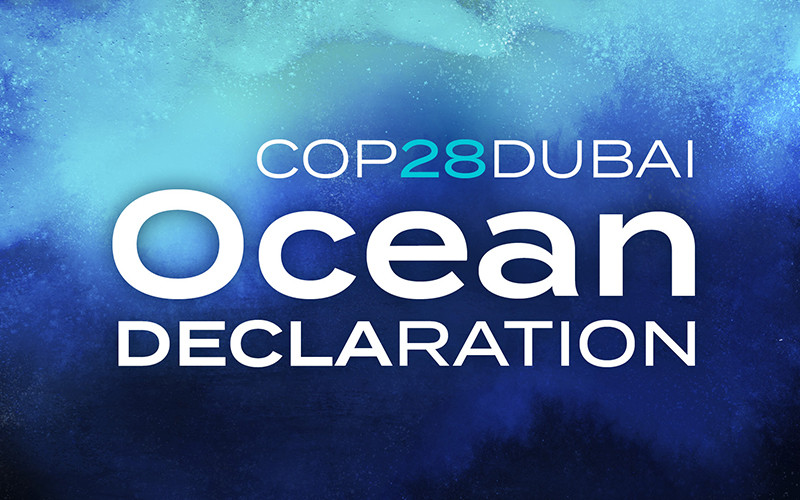Ocean Pavilion Partners Unveil COP28 Dubai Ocean Declaration in Advance of UN Climate Conference
Ocean Pavilion Partners Unveil COP28 Dubai Ocean Declaration in ... Scripps Institution of Oceanography


Partners Call for Recognition of Ocean’s Importance in Climate at COP28

Partners of the Ocean Pavilion at COP28 and associated stakeholders are calling on world leaders to recognize the importance of the ocean in climate and support efforts to expand and improve ocean observations worldwide, including expanding coverage in under-observed regions. The COP28 Dubai Ocean Declaration comes ahead of the annual United Nations Framework Convention on Climate Change (UNFCCC) Conference of the Parties (COP), to be held in Dubai, United Arab Emirates, November 30 – December 12, and emphasizes the need for ocean science and observations as critical for understanding ongoing global climate changes.
The Role of the Ocean in Climate Regulation
The ocean plays a critical role in regulating Earth’s climate and has absorbed more than 90% of the excess heat and almost 30% of the excess carbon dioxide caused by human activity. Consequences of these changes include extreme weather events, rising sea levels, ocean acidification, coral reef mortality, and an increase in low-oxygen zones. Despite this, international investment in ocean observing systems has not kept pace with the need for critical information to guide decision-making. As a result, a central theme of the COP28 Dubai Ocean Declaration is a call on world leaders to “support and foster efforts to greatly expand and improve ocean observations worldwide.”
Addressing Climate Change Goals with Ocean-Based Solutions
As the planet continues on a path to exceed 1.5°C increase over pre-industrial temperatures, the Intergovernmental Panel on Climate Change (IPCC) has concluded that society may need to bolster emissions cuts with atmospheric carbon dioxide removal to meet the goals laid out in the Paris Agreement. A 2021 report by the National Academies of Science, Engineering and Medicine found that natural ocean processes could help, but that accelerated research is needed to assess the benefits, risks, and potential for responsible scale-up of the most promising ocean-based carbon dioxide removal strategies.
The Key Points of the COP28 Dubai Ocean Declaration
The COP28 Dubai Ocean Declaration calls on the parties of the UN Climate Conference to adopt measures that enhance protections of the ocean and include several key points into the two-week long negotiations. According to the Declaration, “As the largest, most dynamic reservoir of carbon in Earth’s climate system, the ocean can and must play a central role in efforts to achieve net-negative emissions and meet the goals laid out in the Paris Agreement. As a critical part of other life-sustaining planetary processes, the ocean must also be protected from continued anthropogenic change, including any climate mitigation efforts and especially as the rapidly changing Earth system becomes less predictable.”
The Declaration underscores the call for drastic cuts of greenhouse gas emissions and immediate concrete efforts to curb other human-induced damages to the ocean, such as overfishing, habitat destruction, and marine pollution, in addition to advancing ocean-based solutions.
Specific efforts spelled out in the COP28 Dubai Ocean Declaration include:
- Improve global stocktake estimates and measures of progress towards goals laid out in the Paris Agreement by providing better measures of carbon fluxes through the ocean and a more comprehensive view of Earth’s ocean-climate system.
- Implement robust, cooperative environmental monitoring, reporting, and verification of new and emerging ocean-based carbon dioxide removal strategies to ensure measurable progress towards net-negative emissions while also protecting critical ocean ecosystems.
- Expand observing capabilities to measure the widest possible suite of essential climate and biological variables to better understand and address the impacts of climate change on the distribution of ocean life, marine ecosystem health, biomass, and biodiversity.
- Develop capacity among island nations and developing countries and refine methods to account for contributions by the ocean’s natural functions and the blue economy to climate stabilization through nationally determined contributions and national adaptation plans.
Importance of Ocean Observations for Climate Solutions
“The immediate priority is to drastically reduce carbon emissions within the next decade,” said Peter de Menocal, President and Director of the Woods Hole Oceanographic Institution, a co-signer of the Declaration. “At the same time, we must explore ways to remove existing emissions from the atmosphere to meet the goals laid out in the Paris Agreement. The ocean presents viable, scalable opportunities for carbon dioxide removal. But independent science must lead, and this requires a new era of collaborative, international ocean observing to track changes in ocean carbon flows, ecosystem health, and to monitor the vital signs of a vast and rapidly changing ocean upon which we all depend.”
The Ocean Pavilion at COP28
The Ocean Pavilion is a dedicated space in the Blue Zone at COP28 that returns for a second year to put the ocean center-stage at a crucial time in international climate negotiations. The pavilion brings together diverse and influential partners who will call for ocean-focused solutions to be recognized as critical in the world’s response to the climate crisis. Throughout the two-week conference, the pavilion will feature more than 80 events, meetings, and in-depth discussions that elaborate on a set of conference themes, including Rising Seas, Climate & the Living Ocean, and Blue Economy & Finance. Visitors will also be able to learn more about the work of Ocean Pavilion partners and to speak with scientists, thought leaders, and students engaged in the search for solutions to some of the world’s most pressing challenges.
More than 40 international ocean science, policy, and philanthropic organizations have signed the COP28 Dubai Ocean Declaration to date.
More information about the Ocean Pavilion and COP28 UAE can be found on the pavilion website and by signing up to receive email updates from COP28.
SDGs, Targets, and Indicators in the Article
1. Which SDGs are addressed or connected to the issues highlighted in the article?
- SDG 13: Climate Action
- SDG 14: Life Below Water
2. What specific targets under those SDGs can be identified based on the article’s content?
- SDG 13.2: Integrate climate change measures into national policies, strategies, and planning.
- SDG 14.2: By 2020, sustainably manage and protect marine and coastal ecosystems to avoid significant adverse impacts.
3. Are there any indicators mentioned or implied in the article that can be used to measure progress towards the identified targets?
- Indicator for SDG 13.2: Availability of national policies, strategies, and plans that integrate climate change measures.
- Indicator for SDG 14.2: Extent of protection and management of marine and coastal ecosystems.
Table: SDGs, Targets, and Indicators
| SDGs | Targets | Indicators |
|---|---|---|
| SDG 13: Climate Action | 13.2: Integrate climate change measures into national policies, strategies, and planning. | Availability of national policies, strategies, and plans that integrate climate change measures. |
| SDG 14: Life Below Water | 14.2: By 2020, sustainably manage and protect marine and coastal ecosystems to avoid significant adverse impacts. | Extent of protection and management of marine and coastal ecosystems. |
The article addresses the issues related to climate change and the importance of the ocean in mitigating its impacts. This aligns with SDG 13: Climate Action, which aims to take urgent action to combat climate change and its impacts. Additionally, the article highlights the need to protect and manage marine and coastal ecosystems, which is connected to SDG 14: Life Below Water, focusing on the conservation and sustainable use of the ocean’s resources.
Based on the article’s content, the specific targets that can be identified are SDG 13.2, which calls for integrating climate change measures into national policies, strategies, and planning, and SDG 14.2, which aims to sustainably manage and protect marine and coastal ecosystems to avoid significant adverse impacts.
The indicators mentioned or implied in the article that can be used to measure progress towards these targets are the availability of national policies, strategies, and plans that integrate climate change measures (indicator for SDG 13.2) and the extent of protection and management of marine and coastal ecosystems (indicator for SDG 14.2).
Behold! This splendid article springs forth from the wellspring of knowledge, shaped by a wondrous proprietary AI technology that delved into a vast ocean of data, illuminating the path towards the Sustainable Development Goals. Remember that all rights are reserved by SDG Investors LLC, empowering us to champion progress together.
Source: scripps.ucsd.edu

Join us, as fellow seekers of change, on a transformative journey at https://sdgtalks.ai/welcome, where you can become a member and actively contribute to shaping a brighter future.







